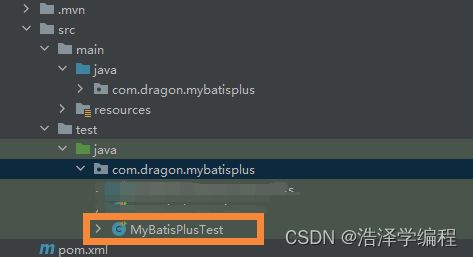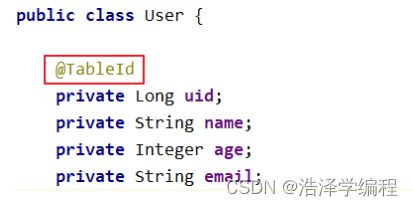MyBatisPlus之基本CRUD、常用注解
文章目录
- 前言
- 一、MyBatisPlus简介
-
- 1.简介
- 2.特性
- 二、基本CRUD
-
- 1.依赖
- 2.搭建基本结构
- 3.BaseMapper
- 4.使用
-
- 插入
- 删除
-
- (1)通过id删除记录
- (2)通过id批量删除记录
- (3)通过map条件删除记录
- 修改
- 查询
-
- (1)根据id查询用户信息
- (2)根据多个id查询多个用户信息
- (3)通过map条件查询用户信息
- (4)查询所有数据
- 通用Service
-
- (1)IService
- (2)创建Service接口和实现类
- (3)测试查询记录数
- (4)测试批量插入
- 三、常用注解
-
- 1.@TableName
- 2. @TableId
-
- @TableId的value属性
- @TableId的type属性
- 3.@TableField
- 4.@TableLogic
- 总结
前言
MyBatis-Plus基本CRUD操作和常用注解讲解。
一、MyBatisPlus简介
1.简介
MyBatis-Plus(简称 MP)是一个 MyBatis的增强工具,在 MyBatis 的基础上只做增强不做改变,为简化开发、提高效率而生。
2.特性
- 无侵入:只做增强不做改变,引入它不会对现有工程产生影响,如丝般顺滑
- 损耗小:启动即会自动注入基本 CURD,性能基本无损耗,直接面向对象操作
- 强大的 CRUD 操作:内置通用 Mapper、通用 Service,仅仅通过少量配置即可实现单表大部分CRUD 操作,更有强大的条件构造器,满足各类使用需求
- 支持 Lambda 形式调用:通过 Lambda 表达式,方便的编写各类查询条件,无需再担心字段写错
- 支持主键自动生成:支持多达 4 种主键策略(内含分布式唯一 ID 生成器 - Sequence),可自由
配置,完美解决主键问题 - 支持 ActiveRecord 模式:支持 ActiveRecord 形式调用,实体类只需继承 Model 类即可进行强大的 CRUD 操作
- 支持自定义全局通用操作:支持全局通用方法注入( Write once, use anywhere )
- 内置代码生成器:采用代码或者 Maven 插件可快速生成 Mapper 、 Model 、 Service 、
Controller 层代码,支持模板引擎,更有超多自定义配置等您来使用 - 内置分页插件:基于 MyBatis 物理分页,开发者无需关心具体操作,配置好插件之后,写分页等同于普通 List 查询
- 分页插件支持多种数据库:支持 MySQL、MariaDB、Oracle、DB2、H2、HSQL、SQLite、
Postgre、SQLServer 等多种数据库 - 内置性能分析插件:可输出 SQL 语句以及其执行时间,建议开发测试时启用该功能,能快速揪出慢查询
- 内置全局拦截插件:提供全表 delete 、 update 操作智能分析阻断,也可自定义拦截规则,预防误操作
二、基本CRUD
1.依赖
注意在idea安装Lombok插件:setting–>Plugins–>搜索Lombok安装
<dependencies>
<dependency>
<groupId>org.springframework.bootgroupId>
<artifactId>spring-boot-starterartifactId>
dependency>
<dependency>
<groupId>org.springframework.bootgroupId>
<artifactId>spring-boot-starter-testartifactId>
<scope>testscope>
dependency>
<dependency>
<groupId>com.baomidougroupId>
<artifactId>mybatis-plus-boot-starterartifactId>
<version>3.5.1version>
dependency>
<dependency>
<groupId>org.projectlombokgroupId>
<artifactId>lombokartifactId>
<optional>trueoptional>
dependency>
<dependency>
<groupId>mysqlgroupId>
<artifactId>mysql-connector-javaartifactId>
<scope>runtimescope>
dependency>
dependencies>
2.搭建基本结构
application.yaml:
spring:
# 配置数据源信息
datasource:
# 配置数据源类型
type: com.zaxxer.hikari.HikariDataSource
# 配置连接数据库信息
driver-class-name: com.mysql.cj.jdbc.Driver
url: jdbc:mysql://localhost:3306/mybatis_plus
username: root
password: root
# 配置MyBatis日志
mybatis-plus:
configuration:
log-impl: org.apache.ibatis.logging.stdout.StdOutImpl
1、驱动类driver-class-name
spring boot 2.0(内置jdbc5驱动),驱动类使用:
driver-class-name: com.mysql.jdbc.Driver
spring boot 2.1及以上(内置jdbc8驱动),驱动类使用:
driver-class-name: com.mysql.cj.jdbc.Driver
否则运行测试用例的时候会有 WARN 信息
2、连接地址url
MySQL5.7版本的url:
jdbc:mysql://localhost:3306/mybatis_plus?characterEncoding=utf-8&useSSL=false
MySQL8.0版本的url:
jdbc:mysql://localhost:3306/mybatis_plus?serverTimezone=GMT%2B8&characterEncoding=utf-8&useSSL=false
否则运行测试用例报告如下错误:
java.sql.SQLException: The server time zone value ‘Öйú±ê׼ʱ¼ä’ is unrecognized or
represents more
启动类:
@SpringBootApplication
@MapperScan("com.dragon.mybatisplus.mapper")
public class MyBatisPlusApplication {
public static void main(String[] args) {
SpringApplication.run(MyBatisPlusApplication.class, args);
}
}
实体:
@Data //lombok注解
public class User {
private Long id;
private String name;
private Integer age;
private String email;
}
mapper:
public interface UserMapper extends BaseMapper<User> {
}
3.BaseMapper
MyBatis-Plus中的基本CRUD在内置的BaseMapper中都已得到了实现,我们可以直接使用,接口如下:
package com.baomidou.mybatisplus.core.mapper;
public interface BaseMapper<T> extends Mapper<T> {
/**
* 插入一条记录
* @param entity 实体对象
*/
int insert(T entity);
/**
* 根据 ID 删除
* @param id 主键ID
*/
int deleteById(Serializable id);
/**
* 根据实体(ID)删除
* @param entity 实体对象
* @since 3.4.4
*/
int deleteById(T entity);
/**
* 根据 columnMap 条件,删除记录
* @param columnMap 表字段 map 对象
*/
int deleteByMap(@Param(Constants.COLUMN_MAP) Map<String, Object> columnMap);
/**
* 根据 entity 条件,删除记录
* @param queryWrapper 实体对象封装操作类(可以为 null,里面的 entity 用于生成 where
语句)
*/
int delete(@Param(Constants.WRAPPER) Wrapper<T> queryWrapper);
/**
* 删除(根据ID 批量删除)
* @param idList 主键ID列表(不能为 null 以及 empty)
*/
int deleteBatchIds(@Param(Constants.COLLECTION) Collection<? extends
Serializable> idList);
/**
* 根据 ID 修改
* @param entity 实体对象
*/
int updateById(@Param(Constants.ENTITY) T entity);
/**
* 根据 whereEntity 条件,更新记录
* @param entity 实体对象 (set 条件值,可以为 null)
* @param updateWrapper 实体对象封装操作类(可以为 null,里面的 entity 用于生成
where 语句)
*/
int update(@Param(Constants.ENTITY) T entity, @Param(Constants.WRAPPER)
Wrapper<T> updateWrapper);
/**
* 根据 ID 查询
* @param id 主键ID
*/
T selectById(Serializable id);
/**
* 查询(根据ID 批量查询)
* @param idList 主键ID列表(不能为 null 以及 empty)
*/
List<T> selectBatchIds(@Param(Constants.COLLECTION) Collection<? extends
Serializable> idList);
/**
* 查询(根据 columnMap 条件)
* @param columnMap 表字段 map 对象
*/
List<T> selectByMap(@Param(Constants.COLUMN_MAP) Map<String, Object>
columnMap);
/**
更多Java –大数据 – 前端 – UI/UE - Android - 人工智能资料下载,可访问百度:尚硅谷官网(www.atguigu.com)
* 根据 entity 条件,查询一条记录
* 查询一条记录,例如 qw.last("limit 1") 限制取一条记录, 注意:多条数据会报异常
* @param queryWrapper 实体对象封装操作类(可以为 null)
*/
default T selectOne(@Param(Constants.WRAPPER) Wrapper<T> queryWrapper) {
List<T> ts = this.selectList(queryWrapper);
if (CollectionUtils.isNotEmpty(ts)) {
if (ts.size() != 1) {
throw ExceptionUtils.mpe("One record is expected, but the query
result is multiple records");
}
return ts.get(0);
}
return null;
}
/**
* 根据 Wrapper 条件,查询总记录数
* @param queryWrapper 实体对象封装操作类(可以为 null)
*/
Long selectCount(@Param(Constants.WRAPPER) Wrapper<T> queryWrapper);
/**
* 根据 entity 条件,查询全部记录
* @param queryWrapper 实体对象封装操作类(可以为 null)
*/
List<T> selectList(@Param(Constants.WRAPPER) Wrapper<T> queryWrapper);
/**
* 根据 Wrapper 条件,查询全部记录
* @param queryWrapper 实体对象封装操作类(可以为 null)
*/
List<Map<String, Object>> selectMaps(@Param(Constants.WRAPPER) Wrapper<T>
queryWrapper);
/**
* 根据 Wrapper 条件,查询全部记录
* 注意: 只返回第一个字段的值
* @param queryWrapper 实体对象封装操作类(可以为 null)
*/
List<Object> selectObjs(@Param(Constants.WRAPPER) Wrapper<T> queryWrapper);
/**
* 根据 entity 条件,查询全部记录(并翻页)
* @param page 分页查询条件(可以为 RowBounds.DEFAULT)
* @param queryWrapper 实体对象封装操作类(可以为 null)
*/
<P extends IPage<T>> P selectPage(P page, @Param(Constants.WRAPPER)
Wrapper<T> queryWrapper);
/**
* 根据 Wrapper 条件,查询全部记录(并翻页)
* @param page 分页查询条件
* @param queryWrapper 实体对象封装操作类
*/
<P extends IPage<Map<String, Object>>> P selectMapsPage(P page,
@Param(Constants.WRAPPER) Wrapper<T> queryWrapper);
}
4.使用
插入
@Test
public void testInsert(){
User user = new User(null, "张三", 23, "[email protected]");
//INSERT INTO user ( id, name, age, email ) VALUES ( ?, ?, ?, ? )
int result = userMapper.insert(user);
System.out.println("受影响行数:"+result);
//1712667990465859586
System.out.println("id自动获取:"+user.getId());
}
最终执行的结果,所获取的id为1712667990465859586(你们生成的肯定和我不一样)
这是因为MyBatis-Plus在实现插入数据时,会默认基于雪花算法的策略生成id
如果你设置了id就会按照你设置的插入。
删除
(1)通过id删除记录
@Test
public void testDeleteById(){
//通过id删除用户信息
//DELETE FROM user WHERE id=?
int result = userMapper.deleteById(1712667990465859586L);
//这个是上面插入数据的id,末尾L是告知是Long类型的,该数超过整型int了
System.out.println("受影响行数:"+result);
}
(2)通过id批量删除记录
@Test
public void testDeleteBatchIds(){
//通过多个id批量删除
//DELETE FROM user WHERE id IN ( ? , ? , ? )
List<Long> idList = Arrays.asList(1L, 2L, 3L);
int result = userMapper.deleteBatchIds(idList);
System.out.println("受影响行数:"+result);
}
(3)通过map条件删除记录
@Test
public void testDeleteByMap(){
//根据map集合中所设置的条件删除记录
//DELETE FROM user WHERE name = ? AND age = ?
Map<String, Object> map = new HashMap<>();
map.put("age", 23);
map.put("name", "张三");
int result = userMapper.deleteByMap(map);
System.out.println("受影响行数:"+result);
}
修改
@Test
public void testUpdateById(){
User user = new User(4L, "admin", 22, null);
//UPDATE user SET name=?, age=? WHERE id=?
int result = userMapper.updateById(user);
System.out.println("受影响行数:"+result);
}
查询
(1)根据id查询用户信息
@Test
public void testSelectById(){
//根据id查询用户信息
//SELECT id,name,age,email FROM user WHERE id=?
User user = userMapper.selectById(4L);
System.out.println(user);
}
(2)根据多个id查询多个用户信息
@Test
public void testSelectBatchIds(){
//根据多个id查询多个用户信息
//SELECT id,name,age,email FROM user WHERE id IN ( ? , ? )
List<Long> idList = Arrays.asList(4L, 5L);
List<User> list = userMapper.selectBatchIds(idList);
list.forEach(System.out::println);
}
(3)通过map条件查询用户信息
@Test
public void testSelectByMap(){
//通过map条件查询用户信息
//SELECT id,name,age,email FROM user WHERE name = ? AND age = ?
Map<String, Object> map = new HashMap<>();
map.put("age", 22);
map.put("name", "admin");
List<User> list = userMapper.selectByMap(map);
list.forEach(System.out::println);
}
(4)查询所有数据
@Test
public void testSelectList(){
//查询所有用户信息
//SELECT id,name,age,email FROM user
List<User> list = userMapper.selectList(null);
list.forEach(System.out::println);
}
通过观察BaseMapper中的方法,大多方法中都有Wrapper类型的形参,此为条件构造器,可针
对于SQL语句设置不同的条件,若没有条件,则可以为该形参赋值null,即查询(删除/修改)所
有数据。
通用Service
说明:
- 通用 Service CRUD 封装IService接口,进一步封装 CRUD 采用 get 查询单行 remove 删
除 list 查询集合 page 分页 前缀命名方式区分 Mapper 层避免混淆- 泛型 T 为任意实体对象
- 建议如果存在自定义通用 Service 方法的可能,请创建自己的 IBaseService 继承
Mybatis-Plus 提供的基类- 官网地址:https://baomidou.com/pages/49cc81/#service-crud-%E6%8E%A5%E5%8F%
A3
(1)IService
MyBatis-Plus中有一个接口 IService和其实现类 ServiceImpl,封装了常见的业务层逻辑
详情查看源码IService和ServiceImpl
(2)创建Service接口和实现类
/**
* UserService继承IService模板提供的基础功能
*/
public interface UserService extends IService<User> {
}
/**
* ServiceImpl实现了IService,提供了IService中基础功能的实现
* 若ServiceImpl无法满足业务需求,则可以使用自定的UserService定义方法,并在实现类中实现
*/
@Service
public class UserServiceImpl extends ServiceImpl<UserMapper, User> implements
UserService {
}
(3)测试查询记录数
@Autowired
private UserService userService;
@Test
public void testGetCount(){
long count = userService.count();
System.out.println("总记录数:" + count);
}
(4)测试批量插入
@Test
public void testSaveBatch(){
// SQL长度有限制,海量数据插入单条SQL无法实行,
// 因此MP将批量插入放在了通用Service中实现,而不是通用Mapper
ArrayList<User> users = new ArrayList<>();
for (int i = 0; i < 5; i++) {
User user = new User();
user.setName("ybc" + i);
user.setAge(20 + i);
users.add(user);
}
//SQL:INSERT INTO t_user ( username, age ) VALUES ( ?, ? )
userService.saveBatch(users);
}
三、常用注解
经过以上的测试,在使用MyBatis-Plus实现基本的CRUD时,我们并没有指定要操作的表,只是在Mapper接口继承BaseMapper时,设置了泛型User,而操作的表为user表。
由此得出结论,MyBatis-Plus在确定操作的表时,由BaseMapper的泛型决定,即实体类型决定,且默认操作的表名和实体类型的类名一致。
1.@TableName
若实体类类型的类名和要操作的表的表名不一致
如表中是t_user,实体类是User,在实体类类型上添加@TableName(“t_user”),标识实体类对应的表,即可成功执行SQL语句
在开发的过程中,我们经常遇到以上的问题,即实体类所对应的表都有固定的前缀,例如t_或tbl_
此时,可以使用MyBatis-Plus提供的全局配置,为实体类所对应的表名设置默认的前缀,那么就不需要在每个实体类上通过@TableName标识实体类对应的表。
mybatis-plus:
configuration:
log-impl: org.apache.ibatis.logging.stdout.StdOutImpl
global-config:
db-config:
# 配置MyBatis-Plus操作表的默认前缀
table-prefix: t_
2. @TableId
经过以上的测试,MyBatis-Plus在实现CRUD时,会默认将id作为主键列,并在插入数据时,默认
基于雪花算法的策略生成id。
若实体类和表中表示主键的不是id,而是其他字段,例如uid,在实体类中uid属性上通过@TableId将其标识为主键,即可成功执行SQL语句
@TableId的value属性
若实体类中主键对应的属性为id,而表中表示主键的字段为uid,此时若只在属性id上添加注解
@TableId,则抛出异常Unknown column ‘id’ in ‘field list’,即MyBatis-Plus仍然会将id作为表的
主键操作,而表中表示主键的是字段uid
此时需要通过@TableId注解的value属性,指定表中的主键字段,@TableId(“uid”)或@TableId(value=“uid”)
@TableId的type属性
type属性用来定义主键策略
常用的主键策略:
| 值 | 描述 |
|---|---|
| IdType.ASSIGN_ID(默 | |
| 认) | 基于雪花算法的策略生成数据id,与数据库id是否设置自增无关 |
| IdType.AUTO | 使用数据库的自增策略,注意,该类型请确保数据库设置了id自增,否则无效 |
配置全局主键策略:
mybatis-plus:
configuration:
log-impl: org.apache.ibatis.logging.stdout.StdOutImpl
global-config:
db-config:
table-prefix: t_
# 配置MyBatis-Plus的主键策略
id-type: auto
3.@TableField
若实体类中的属性使用的是驼峰命名风格,而表中的字段使用的是下划线命名风格
例如实体类属性userName,表中字段user_name
此时MyBatis-Plus会自动将下划线命名风格转化为驼峰命名风格
相当于在MyBatis中配置
若实体类中的属性和表中的字段不满足下划线
例如实体类属性name,表中字段username
此时需要在实体类属性上使用@TableField(“username”)设置属性所对应的字段名
4.@TableLogic
逻辑删除
- 物理删除:真实删除,将对应数据从数据库中删除,之后查询不到此条被删除的数据
- 逻辑删除:假删除,将对应数据中代表是否被删除字段的状态修改为“被删除状态”,之后在数据库中仍旧能看到此条数据记录
- 使用场景:可以进行数据恢复
@Test
public void testDeleteById(){
//通过id删除用户信息
//DELETE FROM user WHERE id=?
int result = userMapper.deleteById(1712702194062888961L);
System.out.println("受影响行数:"+result);
}
总结
以上就是MyBatisPlus的有关讲解。








